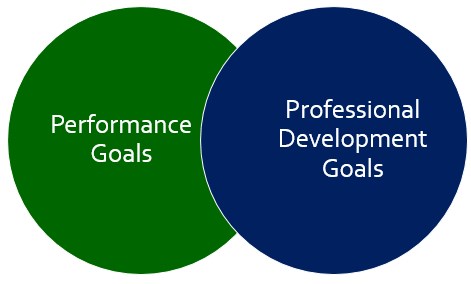Performance Goals and Professional Development Goals
Organizational Goals
Annually, organizations create strategic goals for themselves that target key objectives they will strive to achieve over the course of the upcoming year. These goals are tied to the company’s mission and vision statements. These goals help management and employees know what is important and what direction the organization is headed. It also helps ensure that each employee within the organization knows how their job fits in with the “Big Picture.”
Most organizations also create goals for each individual employee. These individual goals are designed to help the organization as a whole meet their strategic goals. It is critical to the business success that the organizational goals align with the employees goals. This is because, it is easier to reach the organization’s goals if all the employees’ goals are linked and in sync with what the organization wants to achieve.
Types of Employee Goals
Employee goals describe the employee’s top priorities for the upcoming year.
These goals can be often dived into two categories;
- Performance Goals and
- Professional Development Goals
Performance goals describe important job responsibilities and what key performance outcomes the employees should be attempting to achieve. They are often linked to the company’s key performance indicators (KPI).
Some companies also create professional development goals. These goals are related to enhancing the employee’s skills and ability for performing their job functions.
Performance Goals and Professional Development Goals
About Performance Goals
Performance goals are performance expectations related to job responsibilities that are to be accomplished over a course of a business year.
Performance goals are short-term objectives set for specific duties or tasks in an employees’ current job position. These goals are usually related to the overall company goals or specific department goals where the employee works. They help the individual know what is expected of them in their current position.
A performance goal are results-based statements of the employee’s important ongoing job responsibilities. They focus is on task performance and the end result. To be effective, it is important that they are clearly defined and easy to measure.
Examples:
- Increase sales by 15 percent by the end of the next fiscal year.
- Reduce expenses by 10 percent by the third quarter.
- Attain 80 percent customer satisfaction on customer surveys by December, 2017
About Professional Development Goals
Professional development goals are focused on improving and increasing an individual’s capabilities and competencies through access to learning and training opportunities in the workplace. Professional development can be achieved through many sources including formal training seminars, online webinars, videos, coaching, mentoring, and job sharing.
Professional development goals are intended to increase one’s knowledge or skill set. These types of goals focus on plans for learning or enhancing a person’s ability.
An organization’s commitment to employee development helps increases personal job satisfaction and employee motivation. It also helps build and maintain morale of the staff.
Examples:
- Attend 6 seminars on Conflict Resolution by the end of the next fiscal year.
- Take 2 college courses in Business Management by the end of the next fiscal year.
- Achieve a score of 80 percent or higher on four online courses offered by Human Resources.
Difference between Performance Goals and Development Goals
The primary difference between the two types of goal is that performance goals focus on an end result while development goals focus on the attainment of skills and knowledge. Additionally, performance goals are job-oriented, while developmental goals are learning-oriented.
Difference between Performance and Development Goals
Performance Goals are:
- Results-oriented
- Job-oriented
- Focused on task performance
- Related to job responsibilities
- Appropriate to the current position
- Directly aligned to corporate strategic goals
Professional Development Goals are:
- Skill and/or knowledge oriented
- Learning-oriented
- Focus on knowledge or skill attainment
- Directly aligned with the individual’s performance goals
- Supports both current and future job functions and goals
- Provides career advancement opportunities
Working Together
Although, there are significant difference between performance goals and professional development goals, both types are needed to be successful. Both types work hand in hand to ensure employees understand what success is and have the knowledge and skills required to be successful.
Once an employee has the knowledge and skills necessary to perform a specific task, a performance goal should be set to direct his or her focus and effort on achieving it.



